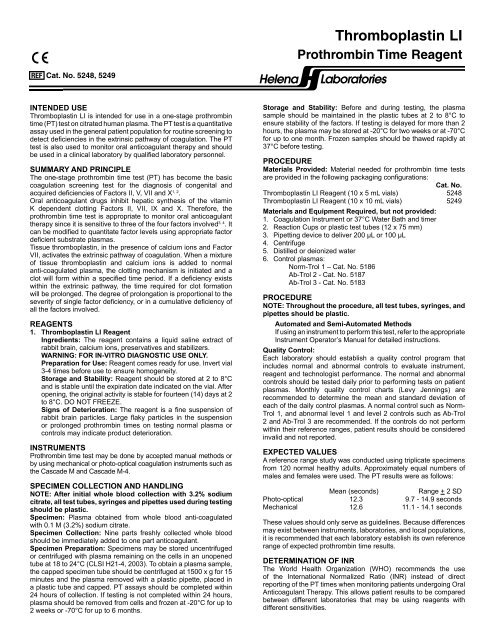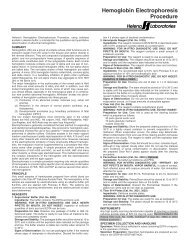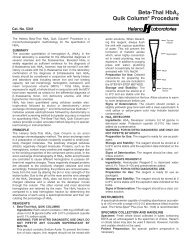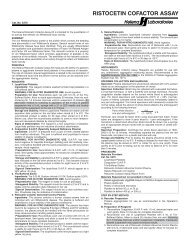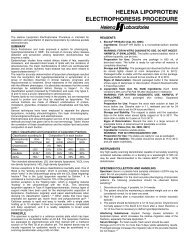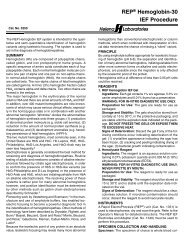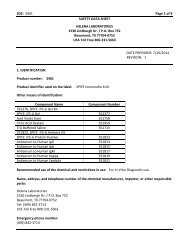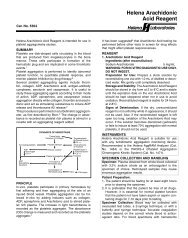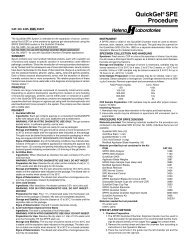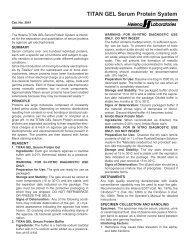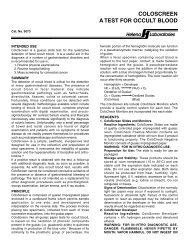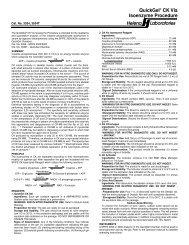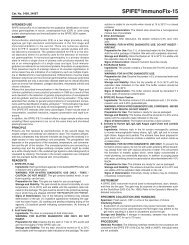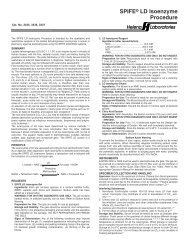Thromboplastin LI Prothrombin Time Reagent - Helena
Thromboplastin LI Prothrombin Time Reagent - Helena
Thromboplastin LI Prothrombin Time Reagent - Helena
- No tags were found...
Create successful ePaper yourself
Turn your PDF publications into a flip-book with our unique Google optimized e-Paper software.
<strong>Thromboplastin</strong> <strong>LI</strong><strong>Prothrombin</strong> <strong>Time</strong> <strong>Reagent</strong>REF Cat. No. 5248, 5249<strong>Helena</strong>LaboratoriesINTENDED USE<strong>Thromboplastin</strong> <strong>LI</strong> is intended for use in a one-stage prothrombintime (PT) test on citrated human plasma. The PT test is a quantitativeassay used in the general patient population for routine screening todetect deficiencies in the extrinsic pathway of coagulation. The PTtest is also used to monitor oral anticoagulant therapy and shouldbe used in a clinical laboratory by qualified laboratory personnel.SUMMARY AND PRINCIPLEThe one-stage prothrombin time test (PT) has become the basiccoagulation screening test for the diagnosis of congenital andacquired deficiencies of Factors II, V, VII and X 1, 2 .Oral anticoagulant drugs inhibit hepatic synthesis of the vitaminK dependent clotting Factors II, VII, IX and X. Therefore, theprothrombin time test is appropriate to monitor oral anticoagulanttherapy since it is sensitive to three of the four factors involved 3, 4 . Itcan be modified to quantitate factor levels using appropriate factordeficient substrate plasmas.Tissue thromboplastin, in the presence of calcium ions and FactorVII, activates the extrinsic pathway of coagulation. When a mixtureof tissue thromboplastin and calcium ions is added to normalanti-coagulated plasma, the clotting mechanism is initiated and aclot will form within a specified time period. If a deficiency existswithin the extrinsic pathway, the time required for clot formationwill be prolonged. The degree of prolongation is proportional to theseverity of single factor deficiency, or in a cumulative deficiency ofall the factors involved.REAGENTS1. <strong>Thromboplastin</strong> <strong>LI</strong> <strong>Reagent</strong>Ingredients: The reagent contains a liquid saline extract ofrabbit brain, calcium ions, preservatives and stabilizers.WARNING: FOR IN-VITRO DIAGNOSTIC USE ONLY.Preparation for Use: <strong>Reagent</strong> comes ready for use. Invert vial3-4 times before use to ensure homogeneity.Storage and Stability: <strong>Reagent</strong> should be stored at 2 to 8°Cand is stable until the expiration date indicated on the vial. Afteropening, the original activity is stable for fourteen (14) days at 2to 8°C. DO NOT FREEZE.Signs of Deterioration: The reagent is a fine suspension ofrabbit brain particles. Large flaky particles in the suspensionor prolonged prothrombin times on testing normal plasma orcontrols may indicate product deterioration.INSTRUMENTS<strong>Prothrombin</strong> time test may be done by accepted manual methods orby using mechanical or photo-optical coagulation instruments such asthe Cascade M and Cascade M-4.SPECIMEN COLLECTION AND HAND<strong>LI</strong>NGNOTE: After initial whole blood collection with 3.2% sodiumcitrate, all test tubes, syringes and pipettes used during testingshould be plastic.Specimen: Plasma obtained from whole blood anti-coagulatedwith 0.1 M (3.2%) sodium citrate.Specimen Collection: Nine parts freshly collected whole bloodshould be immediately added to one part anticoagulant.Specimen Preparation: Specimens may be stored uncentrifugedor centrifuged with plasma remaining on the cells in an unopenedtube at 18 to 24°C (CLSI H21-4, 2003). To obtain a plasma sample,the capped specimen tube should be centrifuged at 1500 x g for 15minutes and the plasma removed with a plastic pipette, placed ina plastic tube and capped. PT assays should be completed within24 hours of collection. If testing is not completed within 24 hours,plasma should be removed from cells and frozen at -20°C for up to2 weeks or -70°C for up to 6 months.Storage and Stability: Before and during testing, the plasmasample should be maintained in the plastic tubes at 2 to 8°C toensure stability of the factors. If testing is delayed for more than 2hours, the plasma may be stored at -20°C for two weeks or at -70°Cfor up to one month. Frozen samples should be thawed rapidly at37°C before testing.PROCEDUREMaterials Provided: Material needed for prothrombin time testsare provided in the following packaging configurations:Cat. No.<strong>Thromboplastin</strong> <strong>LI</strong> <strong>Reagent</strong> (10 x 5 mL vials) 5248<strong>Thromboplastin</strong> <strong>LI</strong> <strong>Reagent</strong> (10 x 10 mL vials) 5249Materials and Equipment Required, but not provided:1. Coagulation Instrument or 37°C Water Bath and timer2. Reaction Cups or plastic test tubes (12 x 75 mm)3. Pipetting device to deliver 200 µL or 100 µL4. Centrifuge5. Distilled or deionized water6. Control plasmas:Norm-Trol 1 – Cat. No. 5186Ab-Trol 2 - Cat. No. 5187Ab-Trol 3 - Cat. No. 5183PROCEDURENOTE: Throughout the procedure, all test tubes, syringes, andpipettes should be plastic.Automated and Semi-Automated MethodsIf using an instrument to perform this test, refer to the appropriateInstrument Operator’s Manual for detailed instructions.Quality Control:Each laboratory should establish a quality control program thatincludes normal and abnormal controls to evaluate instrument,reagent and technologist performance. The normal and abnormalcontrols should be tested daily prior to performing tests on patientplasmas. Monthly quality control charts (Levy Jennings) arerecommended to determine the mean and standard deviation ofeach of the daily control plasmas. A normal control such as Norm-Trol 1, and abnormal level 1 and level 2 controls such as Ab-Trol2 and Ab-Trol 3 are recommended. If the controls do not performwithin their reference ranges, patient results should be consideredinvalid and not reported.EXPECTED VALUESA reference range study was conducted using triplicate specimensfrom 120 normal healthy adults. Approximately equal numbers ofmales and females were used. The PT results were as follows:Mean (seconds)Range + 2 SDPhoto-optical 12.3 9.7 - 14.9 secondsMechanical 12.6 11.1 - 14.1 secondsThese values should only serve as guidelines. Because differencesmay exist between instruments, laboratories, and local populations,it is recommended that each laboratory establish its own referencerange of expected prothrombin time results.DETERMINATION OF INRThe World Health Organization (WHO) recommends the useof the International Normalized Ratio (INR) instead of directreporting of the PT times when monitoring patients undergoing OralAnticoagulant Therapy. This allows patient results to be comparedbetween different laboratories that may be using reagents withdifferent sensitivities.
The INR is calculated by using the ratio of the Patient PT to themean of the normal reference range raised to the power of thereagent International Sensitivity Index (ISI).INR = (Patient PT/mean of normal range) ISIThe ISI is assigned by comparison to a highly sensitive WHOthromboplastin standard reference material. The lower the ISI fora given reagent the more sensitive the reagent is to coagulationfactors. The lot specific ISI value for <strong>Thromboplastin</strong> <strong>LI</strong> can befound on the enclosed ISI calculation sheet.RESULTSThe results of the <strong>Prothrombin</strong> <strong>Time</strong> tests should be reported tothe nearest tenth of a second. Results greater than the upper limitsof the range should be considered abnormal and follow-up testingshould be performed. PT values below the lower limits of the rangemay indicate a compromised sample, and a new sample should becollected.<strong>LI</strong>MITATIONSExpected values for the prothrombin time test will vary from onelaboratory to another, depending on several variables. Theseinclude the method of clot detection, temperature, pH, samplecollection technique, type of anticoagulant and time and methodof plasma storage. Therefore, laboratories should establish theirown expected values for patients and well defined performancestandards for control plasmas. The use of icteric, lipemic, orhemolyzed sample should be avoided due to possible interferenceespecially when using photo-optical instruments. The impact ofother therapeutic drugs, in addition to oral anticoagulant therapy,can influence interpretation of PT test results. Obtaining an accuratepatient history and noting specific drug therapies can help in theproper understanding of the potential impact on laboratory testresults. The presence of heparin as a contaminant in the patientsample must always be considered when an abnormal result isobtained.PERFORMANCE CHARACTERISTICSPrecisionPrecision studies were performed to establish Within-Run andBetween-Run CV’s for normal control plasma and abnormal controlplasma. A single lot number of <strong>Thromboplastin</strong> <strong>LI</strong> reagent was usedfor these studies. Results are shown belowPhoto-optical Within Run Between RunNorm-Trol n 20 60Mean 13.7 13.7SD 0.2 0.2CV% 1.7 1.3Ab-Trol 2 n 20 60Mean 31.3 31.1SD 0.5 0.6CV% 1.6 1.8Ab-Trol 3 n 20 60Mean 66.6 68.6SD 1.5 2.1CV% 2.2 3.1Mechanical Within Run Between RunNorm-Trol n 20 60Mean 14.1 14.4SD 0.3 0.36CV% 2.0 2.5Ab-Trol 2 n 20 60Mean 32.9 32.4SD 0.9 1.1CV% 2.8 3.4Ab-Trol 3 n 20 60Mean 70.4 73.5SD 2.7 3.4CV% 3.9 4.7ComparisonA comparison study was done using the <strong>Thromboplastin</strong> <strong>LI</strong> <strong>Reagent</strong>and another thromboplastin reagent. One hundred five (105)plasma specimens, both normal and abnormal clinical sampleswere tested with both PT reagents. The linear regression equationand coefficient of determination (r 2 ) of the INR values are reported.Photo-opticalN = 105 r 2 = 0.98 Y = 1.065X – 0.1245MechanicalN = 105 r 2 = 0.92 Y = 1.059X – 0.114Y = <strong>Thromboplastin</strong> <strong>LI</strong> reagentX = Reference thromboplastin reagentReferences:1. Quick A.J., The <strong>Prothrombin</strong> <strong>Time</strong> in Hemophilia and inObstructive Jaundice. J. Biol. Chem:109,73-74;1935.2. Biggs R. ed, Human Blood Coagulation Hemostasis andThrombosis Second Ed. Blackwell Scientific Publications,London 1976.3. Peterson C.E., Kwaan H.C., Current Concepts of WarfarinTherapy, Arch Intern. Med. 146:581-584, 1986.4. Loeliger E.A:ICEH/ICTH Recommendations for Reporting<strong>Prothrombin</strong> <strong>Time</strong> in Oral Anticoagulant Control, Throm.Haemost. 53:155-156, 1985.THROMBOPLASTIN <strong>LI</strong> <strong>Reagent</strong>Cat. No.<strong>Thromboplastin</strong> <strong>LI</strong> <strong>Reagent</strong> (10 x 5 mL) 5248<strong>Thromboplastin</strong> <strong>LI</strong> <strong>Reagent</strong> (10 x 10 mL) 5249EQUIPMENT AND SUPP<strong>LI</strong>ESCoagulation S.A.R.P. (10 x 1.0 mL) 5185Norm-Trol Coagulation Control (10 x 1.0 mL) 5186Ab-Trol 1 Coagulation Control (10 x 1.0 mL) 5187Ab-Trol 2 Coagulation Control (10 x 1.0 mL) 5183Cascade M 1710Cascade M-4 1711For Sales, Technical and Order Information and Service Assistance, call800-231-5663 toll free.<strong>Helena</strong> Laboratories warrants its products to meet our published specificationsand to be free from defects in materials and workmanship. <strong>Helena</strong>’s liability underthis contract or otherwise shall be limited to replacement or refund of any amountnot to exceed the purchase price attributable to the goods as to which such claimis made. These alternatives shall be buyer’s exclusive remedies.In no case will <strong>Helena</strong> Laboratories be liable for consequential damages even if<strong>Helena</strong> has been advised as to the possibility of such damages.The foregoing warranties are in lieu of all warranties expressed or impliedincluding, but not limited to, the implied warranties of merchantability and fitnessfor a particular purpose.ECREPEuropean Community Authorized Representative<strong>Helena</strong> Laboratories UK, Ltd.Colima AvenueSunderland Enterprise ParkSunderland SR5 3XBEnglandDistributed by:Pro. 1213/07(3)


